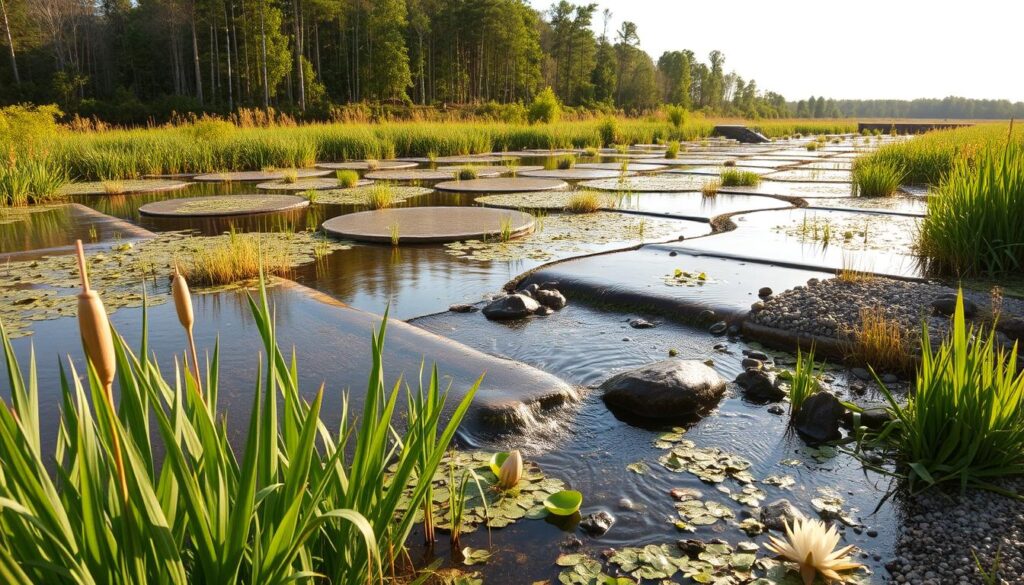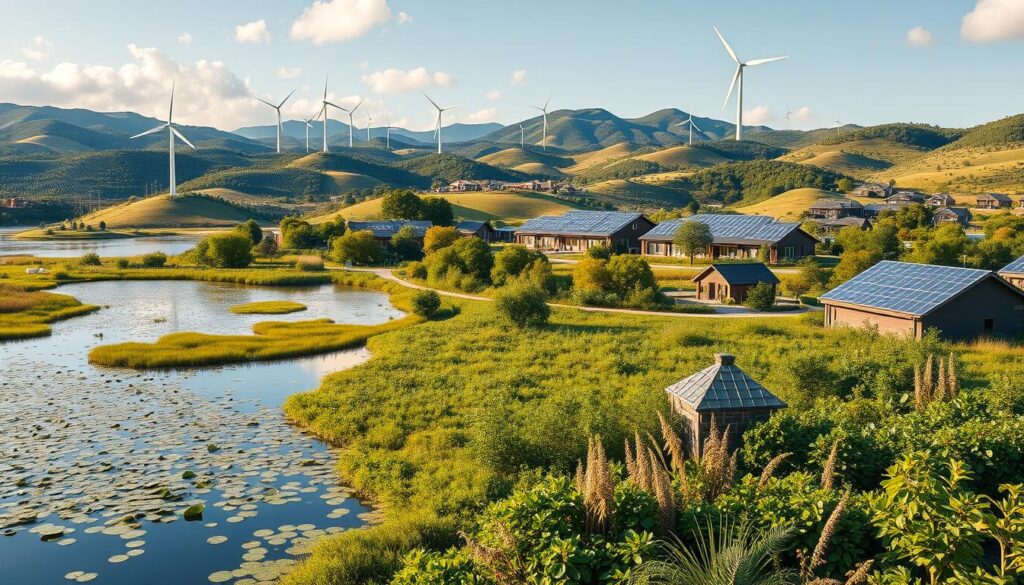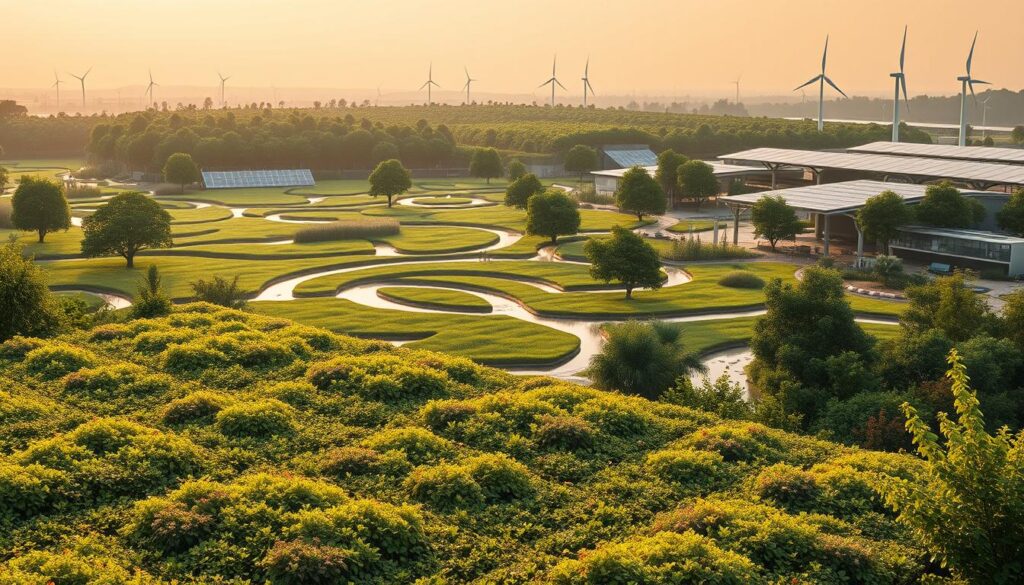Ecological engineering is revolutionizing the way we address environmental challenges. By combining sustainable design and green technology, we can create eco-friendly solutions that benefit both the environment and human societies.
As we face growing environmental challenges, innovative approaches are needed to mitigate their impacts. Ecological engineering offers a promising path forward, leveraging sustainable practices to restore ecosystems and promote biodiversity.
Key Takeaways
- Innovative ecological engineering approaches can effectively address environmental challenges.
- Sustainable design and green technology play crucial roles in eco-friendly solutions.
- Ecological engineering promotes biodiversity and ecosystem restoration.
- Eco-friendly solutions benefit both the environment and human societies.
- Ecological engineering is a promising field for mitigating environmental impacts.
The Evolution and Importance of Ecological Engineering
Ecological engineering represents a paradigm shift in how we approach environmental management. It integrates ecological principles with engineering practices to develop sustainable solutions for environmental challenges.
This field has gained significant attention in recent years due to its potential to address complex environmental issues effectively.
Defining Modern Ecological Engineering
Modern ecological engineering is defined as the design, construction, and restoration of ecosystems. It involves working with natural processes to achieve sustainable solutions for environmental problems.
This approach emphasizes the importance of understanding ecological systems and using this knowledge to develop innovative solutions. Ecological engineering applications range from wetland restoration to sustainable urban planning, showcasing its versatility in addressing various environmental challenges.
Historical Development and Milestones
The history of ecological engineering is rooted in various disciplines, including ecology, engineering, and conservation biology.
Early milestones include the development of ecological theories and the application of engineering principles to environmental problems. Over time, the field has evolved to incorporate new technologies and a deeper understanding of ecological systems.
Significant advancements have been made in areas such as ecosystem restoration and sustainable resource management, highlighting the progress and potential of ecological engineering.
Core Principles of Ecological Design
The practice of ecological design is grounded in a deep understanding of natural processes and the development of self-sustaining systems. Ecological design principles are fundamental to creating ecosystems that are not only resilient but also provide numerous benefits to both the environment and human societies.

Working with Natural Processes
One of the core principles of ecological design is working with natural processes rather than against them. This involves understanding and mimicking the patterns and processes found in nature to create sustainable and resilient ecosystems. By doing so, ecological engineers can develop systems that require less maintenance and are more adaptable to changing environmental conditions.
Ecosystems are complex and dynamic, involving intricate relationships between different species and their environment. Ecological design takes these complexities into account, aiming to restore or enhance the natural balance. This approach not only helps in conserving biodiversity but also in maintaining ecosystem services that are crucial for human well-being.
Self-Sustaining Systems Development
The development of self-sustaining systems is another key aspect of ecological design. These systems are designed to be self-regulating, requiring minimal external inputs and maintenance. Self-sustaining ecosystems are capable of maintaining their structure and function over time, even in the face of environmental disturbances.
To achieve this, ecological engineers focus on creating closed-loop systems where waste is minimized and resources are used efficiently. This not only reduces the environmental footprint of human activities but also contributes to sustainable development by ensuring that natural resources are preserved for future generations.
By integrating ecological design principles into our practices, we can create ecosystems that are more resilient, diverse, and productive. This approach is crucial for addressing the environmental challenges we face today and for promoting sustainable development.
The Science of Ecosystem Restoration
The restoration of ecosystems is grounded in the science of ecological succession and the dynamics of system recovery. Ecosystem restoration is a multifaceted field that seeks to revive degraded or damaged ecosystems, restoring their health, function, and biodiversity.
Ecological Succession and System Dynamics
Ecological succession is the process by which the mix of species and habitats in an area changes over time. Understanding this process is crucial for ecosystem restoration, as it allows practitioners to predict and facilitate the recovery of ecosystems. System dynamics, on the other hand, involve the interactions between different components of an ecosystem, such as between predators and prey, or between plants and their pollinators. Restoration efforts must consider these dynamics to create a balanced and resilient ecosystem.
The study of ecological succession and system dynamics informs the design of restoration projects. For instance, understanding the pioneer species that colonize disturbed areas can help in designing interventions that accelerate the recovery process. Moreover, recognizing the role of disturbances, such as fires or floods, in shaping ecosystem characteristics is essential for creating restoration plans that work with natural processes rather than against them.
Measuring Ecosystem Health and Function
Measuring the health and function of restored ecosystems is critical to assessing the success of restoration efforts. Ecosystem health can be evaluated through indicators such as biodiversity, water quality, and soil health. Ecosystem function refers to the processes and services that ecosystems provide, including carbon sequestration, nutrient cycling, and habitat provision for various species. Effective restoration aims to restore both the health and function of ecosystems, ensuring they can support a diverse range of plant and animal life and provide valuable ecosystem services.
To measure ecosystem health and function, restoration practitioners use a variety of tools and metrics. These can include field surveys to assess biodiversity, water quality monitoring, and remote sensing technologies to track changes in ecosystem characteristics over time. By continuously monitoring these indicators, restoration efforts can be adapted and improved to achieve better outcomes.
Water Management and Purification Techniques
As the global demand for clean water continues to rise, innovative water management techniques are becoming increasingly important. Effective water management is crucial for maintaining ecological balance and supporting human needs. This involves a range of strategies and technologies aimed at conserving, restoring, and protecting water resources.
Constructed Wetlands for Water Treatment
Constructed wetlands are engineered systems designed to mimic natural wetlands for water treatment. These systems utilize natural processes involving vegetation, soils, and microorganisms to remove pollutants and improve water quality. By leveraging these natural processes, constructed wetlands offer a cost-effective and sustainable solution for treating wastewater and managing stormwater runoff.

Watershed Restoration Approaches
Watershed restoration involves rehabilitating degraded watersheds to improve water quality, enhance biodiversity, and restore ecosystem services. This can be achieved through various approaches, including reforestation, habitat restoration, and the implementation of best management practices to reduce pollution. By restoring watersheds, communities can improve the health of their water resources and enhance resilience to climate change.
Integrated Water Resources Management
Integrated Water Resources Management (IWRM) is a holistic approach that considers the social, economic, and environmental dimensions of water management. IWRM promotes the coordinated development and management of water, land, and related resources to maximize economic and social welfare while maintaining the sustainability of ecosystems. By adopting IWRM principles, stakeholders can ensure that water resources are managed in a way that balances competing demands and protects the environment.
By combining these approaches—constructed wetlands, watershed restoration, and integrated water resources management—communities can develop comprehensive water management strategies that address both current and future water challenges.
Soil Conservation and Environmental Remediation
As environmental challenges escalate, the need for robust soil conservation and remediation techniques becomes increasingly apparent. Soil conservation is crucial for maintaining ecosystem health, supporting biodiversity, and ensuring sustainable land use. Environmental remediation, on the other hand, involves the removal of pollutants from the environment, restoring ecosystems to a healthy state.
Bioremediation and Phytoremediation Methods
Bioremediation and phytoremediation are innovative techniques used in environmental remediation. Bioremediation involves the use of microorganisms to degrade or remove contaminants, while phytoremediation utilizes plants to clean up pollutants. These methods are not only effective but also environmentally friendly, offering a sustainable solution to soil and water pollution.
The application of bioremediation and phytoremediation has shown promising results in various contaminated sites. For instance, certain plants can hyperaccumulate heavy metals, reducing their toxicity and making the soil safer for other uses.
| Technique | Description | Application |
|---|---|---|
| Bioremediation | Uses microorganisms to degrade contaminants | Soil and groundwater cleanup |
| Phytoremediation | Utilizes plants to remove or stabilize pollutants | Soil remediation, heavy metal removal |
Sustainable Land Rehabilitation Practices
Sustainable land rehabilitation practices are essential for restoring degraded lands. These practices include reforestation, terracing, and the use of cover crops, which help in preventing soil erosion and improving soil health. By adopting these practices, we can enhance ecosystem services, support biodiversity, and improve livelihoods.
Effective land rehabilitation also involves the integration of local communities in the planning and implementation process. This not only ensures the sustainability of the projects but also provides economic benefits to the communities involved.
Biodiversity Conservation Through Ecological Engineering
The application of ecological engineering principles is vital for conserving biodiversity, as it enables the creation of resilient and diverse ecosystems. Ecological engineering involves the design and restoration of ecosystems that support a wide range of plant and animal species, thereby enhancing biodiversity.

Habitat Creation and Enhancement Strategies
Habitat creation and enhancement are critical components of biodiversity conservation. Ecological engineering techniques such as wetland restoration, reforestation, and the creation of artificial reefs can significantly enhance habitat quality and biodiversity. For instance, constructed wetlands can provide habitat for numerous species, improve water quality, and mitigate the effects of flooding.
According to a study published in the journal Conservation Biology, habitat restoration efforts have been shown to increase species richness by up to 40% in some ecosystems.
“Restoration of degraded habitats not only enhances biodiversity but also provides numerous ecosystem services, including improved water quality and climate regulation.”
Designing for Species Diversity
Designing ecosystems for species diversity involves creating a variety of habitats that support different species. This can be achieved by incorporating diverse landscape features, such as ponds, meadows, and forests, into ecological engineering projects. By promoting species diversity, ecological engineering can help maintain ecosystem resilience and adaptability in the face of environmental changes.
| Ecosystem Feature | Species Supported | Ecosystem Benefit |
|---|---|---|
| Ponds | Amphibians, aquatic plants | Water storage, water quality improvement |
| Meadows | Pollinators, grassland birds | Soil stabilization, carbon sequestration |
| Forests | Tree-dwelling species, forest floor organisms | Climate regulation, timber production |
Ecological Corridors and Connectivity
Ecological corridors are essential for maintaining connectivity between isolated habitats, allowing species to migrate, disperse, and interact. By creating ecological corridors, ecological engineering can help maintain genetic diversity and promote ecosystem health. For example, wildlife corridors can connect fragmented habitats, enabling animals to move freely and maintain healthy populations.
Ecological corridors can be designed to:
- Connect isolated habitats
- Facilitate species migration
- Enhance genetic diversity
Green Infrastructure: Merging Nature with Built Environments
Merging nature with built environments is the essence of green infrastructure, a concept that’s transforming urban landscapes. By integrating natural elements into urban planning, cities can become more sustainable and resilient.
“The future of urban development lies in harmonizing the built and natural environments,” says a leading urban planner. This approach not only enhances the aesthetic appeal of cities but also contributes to environmental sustainability.
Urban Ecological Solutions
Urban ecological solutions are critical in addressing the environmental challenges faced by cities. These solutions involve the use of green roofs, urban parks, and green spaces to mitigate the urban heat island effect, manage stormwater runoff, and improve air quality.
For instance, the use of green roofs can significantly reduce energy consumption by providing insulation to buildings. Moreover, urban parks serve as vital green spaces that improve air quality and provide recreational areas for residents.
Sustainable Infrastructure Design Principles
Sustainable infrastructure design principles are fundamental to the successful implementation of green infrastructure. These principles emphasize the importance of designing infrastructure that is not only eco-friendly but also resilient and adaptable to future environmental changes.
- Use of sustainable materials
- Incorporation of natural systems into infrastructure design
- Design for energy efficiency and reduced carbon footprint
By adopting these principles, cities can develop infrastructure that supports both the environment and the well-being of their citizens.
Climate Resilience and Adaptation Strategies
Building climate resilience is essential for mitigating the far-reaching consequences of climate change on environmental and human systems. As the planet continues to experience rising temperatures and more frequent extreme weather events, the importance of developing and implementing effective climate resilience strategies cannot be overstated.
Climate resilience involves enhancing the ability of communities, ecosystems, and infrastructure to withstand and recover from climate-related stresses. This can be achieved through a combination of ecological approaches to climate change mitigation and adaptation measures.
Ecological Approaches to Climate Change Mitigation
Ecological approaches to climate change mitigation focus on restoring and preserving natural ecosystems that play a crucial role in regulating the climate. Some of these approaches include:
- Restoring wetlands and mangroves to enhance carbon sequestration
- Implementing sustainable forest management practices to maintain forest health and carbon storage
- Promoting agroforestry and permaculture practices to improve soil health and reduce emissions
These ecological strategies not only help mitigate climate change but also provide numerous co-benefits, such as enhancing biodiversity, improving water quality, and supporting local livelihoods.

Designing Resilient Ecosystems
Designing resilient ecosystems is a critical component of climate change adaptation. This involves creating ecosystems that are capable of withstanding the projected impacts of climate change, such as increased temperatures, changing precipitation patterns, and more frequent extreme weather events.
Key strategies for designing resilient ecosystems include:
- Enhancing ecosystem connectivity to allow for species migration and adaptation
- Incorporating climate-smart design principles into ecological restoration projects
- Promoting ecosystem services that support human well-being and climate resilience
By adopting these strategies, we can create ecosystems that are not only more resilient to climate change but also provide essential services and support biodiversity.
Biomimicry and Nature-Based Solutions
Learning from the natural world, biomimicry and nature-based solutions are revolutionizing the way we address environmental problems. By studying and emulating nature’s designs and processes, scientists and engineers can develop innovative, sustainable solutions to complex ecological challenges.
Learning from Natural Systems
Natural systems have evolved over millions of years to develop efficient and sustainable solutions to various challenges. Biomimicry involves analyzing these natural processes and translating them into technological innovations. For instance, the study of spider silk has led to the development of high-strength, lightweight materials.
Innovative Applications in Environmental Challenges
Biomimicry has numerous applications in addressing environmental challenges. For example, inspired by the lotus leaf’s self-cleaning properties, researchers have developed surfaces that reduce maintenance needs and improve efficiency in various industries. Additionally, nature-based solutions such as restoring wetlands and forests help mitigate climate change, improve water quality, and enhance biodiversity.
These eco-friendly technologies not only provide effective solutions but also promote sustainability and environmental stewardship. By embracing biomimicry and nature-based solutions, we can create a more resilient and sustainable future.
Renewable Energy Integration with Ecological Systems
In the quest for a more sustainable energy mix, integrating renewable energy with ecological systems is a critical step forward. This integration not only enhances energy production but also ensures that the environmental impact is minimized.
Eco-Friendly Energy Production Methods
Eco-friendly energy production methods are at the forefront of renewable energy integration. Solar energy, for instance, has seen significant advancements in technology, making it more efficient and accessible. Concentrated Solar Power (CSP) systems and Photovoltaic (PV) systems are leading the way in harnessing solar energy.
“The future of energy lies in our ability to harness renewable sources efficiently and sustainably.” – Renewable Energy Expert
Wind energy is another crucial component, with offshore wind farms becoming increasingly popular due to their higher energy yield and lower visual impact.
| Renewable Energy Source | Eco-Friendly Features |
|---|---|
| Solar Energy | Zero emissions during operation, abundant resource availability |
| Wind Energy | Low operational costs, reduces reliance on fossil fuels |
Minimizing Environmental Impact of Energy Infrastructure
Minimizing the environmental impact of energy infrastructure is crucial for sustainable development. This involves careful planning and implementation of renewable energy projects to avoid or mitigate potential environmental harms.
For example, when constructing wind farms, it’s essential to conduct thorough environmental impact assessments to identify potential risks to local wildlife and ecosystems.

By adopting eco-friendly energy production methods and minimizing the environmental footprint of energy infrastructure, we can achieve a more sustainable and resilient energy future.
Economic and Social Benefits of Ecological Engineering
As the world grapples with environmental challenges, ecological engineering emerges as a vital strategy with significant economic and social benefits. By integrating natural processes with engineering principles, ecological engineering offers sustainable solutions that not only mitigate environmental impacts but also provide economic advantages.
Cost-Effectiveness of Green Solutions
Ecological engineering solutions are often more cost-effective than traditional engineering approaches. For instance, constructed wetlands for water treatment can be significantly cheaper to establish and maintain than conventional water treatment plants. The list below highlights some key cost-effective aspects:
- Reduced infrastructure costs
- Lower operational and maintenance expenses
- Potential for revenue generation through ecosystem services
These green solutions not only save costs but also contribute to sustainability and environmental health.
Ecosystem Services Valuation
Valuing ecosystem services is crucial for understanding the full benefits of ecological engineering. Ecosystem services include processes such as air and water purification, soil formation, and climate regulation. By quantifying these services, decision-makers can better appreciate the economic value of ecological engineering projects. For example, a study might reveal that a wetland restoration project not only improves biodiversity but also provides significant economic benefits through flood control and water quality improvement.
The economic and social benefits of ecological engineering underscore its importance in achieving sustainable development. By embracing ecological engineering, we can create more resilient, cost-effective, and environmentally friendly solutions to the challenges we face.
Case Studies: Transformative Ecological Engineering Projects
Ecological engineering projects have demonstrated substantial positive impacts on the environment, from wetland restoration to urban ecological transformations. These projects not only address environmental challenges but also enhance ecosystem services and biodiversity.

Wetland Restoration Success Stories
Wetland restoration is a significant area where ecological engineering has shown remarkable success. For instance, the restoration of the Cheyenne Bottoms in Kansas, USA, has improved water quality and provided habitat for numerous species. Such projects demonstrate the effectiveness of ecological engineering in restoring degraded ecosystems.
Key strategies in wetland restoration include:
- Re-establishing natural hydrological processes
- Reintroducing native vegetation
- Enhancing soil quality
Urban Ecological Transformations
Urban areas are also benefiting from ecological engineering through the creation of green spaces and restoration of urban water bodies. The High Line in New York City is a notable example, where an abandoned rail line was transformed into a vibrant public park, enhancing urban biodiversity and providing recreational spaces.
| Project | Location | Impact |
|---|---|---|
| Cheyenne Bottoms Restoration | Kansas, USA | Improved water quality, enhanced biodiversity |
| The High Line | New York City, USA | Urban biodiversity enhancement, recreational space creation |
Large-Scale Ecosystem Rehabilitation
Large-scale ecosystem rehabilitation projects, such as the restoration of the Florida Everglades, demonstrate the potential of ecological engineering in revitalizing vast ecosystems. These projects involve complex planning and collaboration among various stakeholders to restore natural processes and ecosystem functions.
By examining these case studies, it becomes evident that ecological engineering is a powerful tool in addressing environmental challenges and promoting sustainability.
Challenges and Future Directions in Ecological Engineering
Ecological engineering, while innovative and promising, is confronted with a range of challenges that must be navigated. As the field continues to grow, addressing these challenges will be crucial to its success and the realization of its full potential.

Technical and Scientific Hurdles
One of the significant challenges facing ecological engineering is the technical and scientific hurdles that arise during project implementation. These can include difficulties in scaling up ecological processes, managing complex ecosystem interactions, and ensuring the long-term sustainability of engineered ecosystems.
For instance, the table below highlights some of the key technical and scientific challenges in ecological engineering:
| Challenge | Description | Potential Solution |
|---|---|---|
| Scaling ecological processes | Difficulty in applying ecological principles at large scales | Development of new technologies and methodologies |
| Managing ecosystem interactions | Complexity of interactions within ecosystems | Advanced modeling and monitoring techniques |
| Ensuring long-term sustainability | Maintaining ecosystem health over time | Adaptive management strategies and continuous monitoring |
Policy and Implementation Barriers
In addition to technical and scientific challenges, ecological engineering also faces policy and implementation barriers. These can include regulatory hurdles, lack of public awareness and support, and difficulties in integrating ecological engineering solutions with existing infrastructure.
To overcome these barriers, it is essential to develop effective policies and implementation strategies that support the growth of ecological engineering. This can involve collaboration between policymakers, practitioners, and the public to raise awareness and build support for ecological engineering projects.
By addressing these challenges and working together, we can unlock the full potential of ecological engineering to address some of the world’s most pressing environmental challenges.
Conclusion: Embracing Nature’s Wisdom for Environmental Solutions
Ecological engineering has emerged as a vital discipline in addressing environmental challenges. By embracing nature’s wisdom, we can develop innovative solutions that promote sustainability and eco-friendly practices.
The integration of ecological principles into engineering practices has shown significant promise in restoring ecosystems, conserving biodiversity, and enhancing environmental resilience. As highlighted in the preceding sections, ecological engineering encompasses a broad range of applications, from water management and soil conservation to green infrastructure and climate resilience.
By adopting a holistic approach that works in harmony with natural processes, ecological engineering offers a pathway to achieving environmental sustainability. The success stories and case studies presented in this article demonstrate the potential of ecological engineering to transform ecosystems and promote eco-friendly solutions.
As we move forward, it is essential to continue exploring and applying the principles of ecological engineering to address the complex environmental challenges we face. By doing so, we can create a more sustainable future and ensure the long-term health of our planet.
